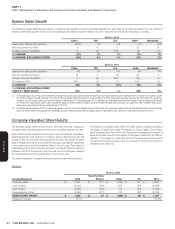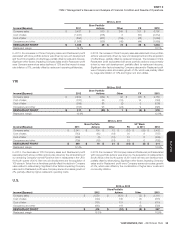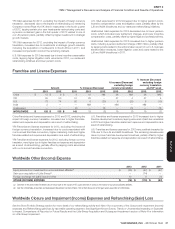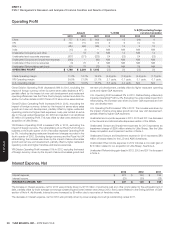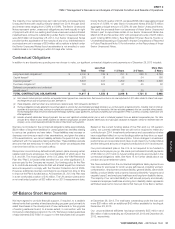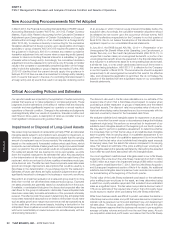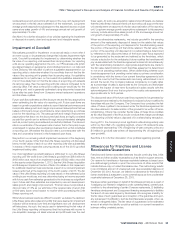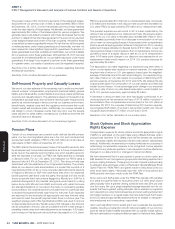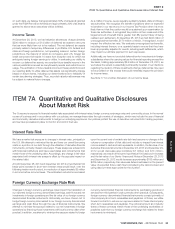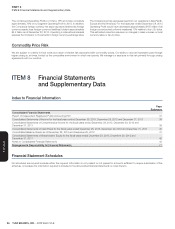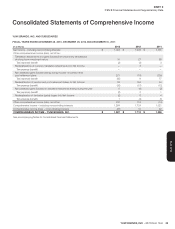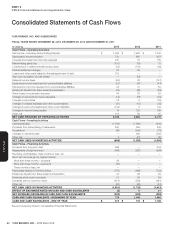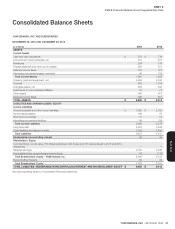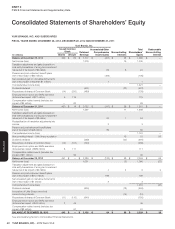Pizza Hut 2013 Annual Report Download - page 129
Download and view the complete annual report
Please find page 129 of the 2013 Pizza Hut annual report below. You can navigate through the pages in the report by either clicking on the pages listed below, or by using the keyword search tool below to find specific information within the annual report.
YUM! BRANDS, INC.-2013 Form10-K 33
Form 10-K
PART II
ITEM7Management’s Discussion and Analysis of Financial Condition and Results of Operations
restaurant-level unit economics will support the new unit development
we assumed in the fair value estimation of the trademark. Long-term
average growth assumptions subsequent to this assumed recovery include
same-store sales growth of 4% and average annual net unit growth of
approximately 75 units.
See Note 2 for a further discussion of our policies regarding the impairment
or disposal of property, plant and equipment and intangible assets.
Impairment of Goodwill
We evaluate goodwill for impairment on an annual basis or more often if
an event occurs or circumstances change that indicates impairment might
exist. Goodwill is evaluated for impairment by determining whether the
fair value of our reporting units exceed their carrying values. Our reporting
units are our operating segments in the U.S., our YRI business units (which
are aligned based on geography) and individual brands in our India and
China Divisions. We may elect to perform a qualitative assessment for our
reporting units to determine whether it is more likely than not that the fair
value of the reporting unit is greater than its carrying value. If a qualitative
assessment is not performed, or if as a result of a qualitative assessment
it is not more likely than not that the fair value of a reporting unit exceeds
its carrying value, then the reporting unit’s fair value is compared to its
carrying value. Fair value is the price a willing buyer would pay for the
reporting unit, and is generally estimated using discounted expected
future after-tax cash flows from Company-owned restaurant operations
and franchise royalties�
Future cash flow estimates and the discount rate are the key assumptions
when estimating the fair value of a reporting unit� Future cash flows are
based on growth expectations relative to recent historical performance and
incorporate sales growth and margin improvement assumptions that we
believe a third-party buyer would assume when determining a purchase
price for the reporting unit� The sales growth and margin improvement
assumptions that factor into the discounted cash flows are highly correlated
as cash flow growth can be achieved through various interrelated strategies
such as product pricing and restaurant productivity initiatives� The discount
rate is our estimate of the required rate of return that a third-party buyer
would expect to receive when purchasing a business from us that constitutes
a reporting unit� We believe the discount rate is commensurate with the
risks and uncertainty inherent in the forecasted cash flows�
We perform our annual goodwill impairment review as of the beginning
of our fourth quarter� Other than the Little Sheep reporting unit discussed
below, the fair values of each of our other reporting units were substantially
in excess of their respective carrying values as of the 2013 goodwill
impairment testing date�
Our most significant goodwill balance is attributed to our Little Sheep
reporting unit. We wrote down Little Sheep’s goodwill from $384 million to
$162 million as a result of an impairment charge of $222 million recorded
in the quarter ended September 7, 2013. See the Little Sheep Acquisition
and Subsequent Impairment section of Note 4 for details on this impairment.
No additional impairment was recorded as a result of our annual impairment
review performed at the beginning of the fourth quarter of 2013. The fair
value of the Little Sheep reporting unit was based on the estimated price
a willing buyer would pay, and was determined using an income approach
with future cash flow estimates generated by the business as a significant
input. Future cash flow estimates are impacted by new unit development,
sales growth and margin improvement. This fair value incorporated a
discount rate of 13% as our estimate of the required rate of return that
a third-party buyer would expect to receive when purchasing the Little
Sheep reporting unit.
While future business results are difficult to predict, we believe the decline in
Little Sheep same-store sales and profits that were deemed an impairment
indicator will be reversed over time and significant new unit development
will take place. As such, the inputs used in determining the fair value of
the Little Sheep reporting unit assumed that the business will recover to
pre-acquisition average unit sales volumes and profit levels over the next
three years. At such pre-acquisition sales and profit levels, we believe
that the Little Sheep restaurant-level unit economics will support the new
unit development we assumed in the fair value estimation of the reporting
unit. Long-term average growth assumptions subsequent to this assumed
recovery include same-store sales growth of 4% and average annual net
unit growth of approximately 75 units.
When we refranchise restaurants, we include goodwill in the carrying
amount of the restaurants disposed of based on the relative fair values
of the portion of the reporting unit disposed of in the refranchising versus
the portion of the reporting unit that will be retained. The fair value of the
portion of the reporting unit disposed of in a refranchising is determined
by reference to the discounted value of the future cash flows expected
to be generated by the restaurant and retained by the franchisee, which
include a deduction for the anticipated, future royalties the franchisee will
pay us associated with the franchise agreement entered into simultaneously
with the refranchising transaction. Appropriate adjustments are made to
the fair value determinations if such franchise agreement is determined
to not be at prevailing market rates. When determining whether such
franchise agreement is at prevailing market rates our primary consideration
is consistency with the terms of our current franchise agreements both
within the country that the restaurants are being refranchised in and
around the world. The Company believes consistency in royalty rates
as a percentage of sales is appropriate as the Company and franchisee
share in the impact of near-term fluctuations in sales results with the
acknowledgment that over the long-term the royalty rate represents an
appropriate rate for both parties.
The discounted value of the future cash flows expected to be generated by
the restaurant and retained by the franchisee is reduced by future royalties the
franchisee will pay the Company. The Company thus considers the fair
value of future royalties to be received under the franchise agreement as
fair value retained in its determination of the goodwill to be written off when
refranchising. Others may consider the fair value of these future royalties
as fair value disposed of and thus would conclude that a larger percentage
of a reporting unit’s fair value is disposed of in a refranchising transaction.
During 2013, the Company’s most significant refranchising activity was
within our Taco Bell U.S. operating segment, where 178 restaurants were
refranchised (representing 17% of beginning-of-year company units) and
$4 million in goodwill was written off (representing 4% of beginning-of-
year goodwill).
See Note 2 for a further discussion of our policies regarding goodwill.
Allowances for Franchise and License
Receivables/Guarantees
Franchise and license receivable balances include continuing fees, initial
fees, rent and other ancillary receivables such as fees for support services.
Our reserve for franchisee or licensee receivable balances is based upon
pre-defined aging criteria or upon the occurrence of other events that
indicate that we may not collect the balance due. This methodology results
in an immaterial amount of unreserved past due receivable balances at
December 28, 2013. As such, we believe our allowance for franchise and
license receivables is adequate to cover potential exposure from uncollectible
receivable balances at December 28, 2013.
We issue certain guarantees on behalf of franchisees primarily as a result of
1) assigning our interest in obligations under operating leases, primarily as a
condition to the refranchising of certain Company restaurants, 2) facilitating
franchisee development and 3) equipment financing arrangements to facilitate
the launch of new sales layers by franchisees. We recognize a liability for
the fair value of such guarantees upon inception of the guarantee and upon
any subsequent modification, such as franchise lease renewals, when we
remain contingently liable. The fair value of a guarantee is the estimated
amount at which the liability could be settled in a current transaction
between willing unrelated parties.



